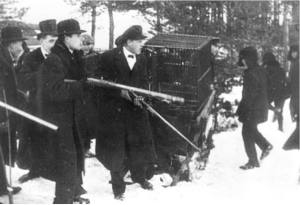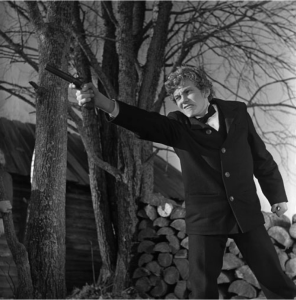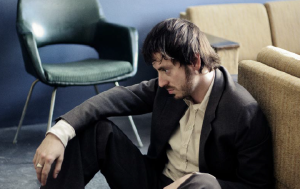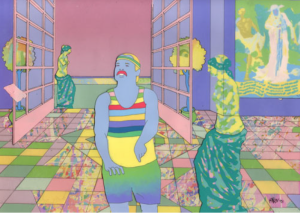The new short film Sauna Day, directed by Anna Hints and Tushar Prakash, was selected to premiere as the first Estonian film in the special programme of La Semaine de la Critique (Critics' Week) at the prestigious Cannes Film Festival.
More…
Estonian Film History
The Birth of Estonian Film
In 2012 Estonian film celebrated its 100th anniversary. Photographer Johannes Pääsuke, who wandered across Estonia taking pictures of farm workers, purchased a film camera in 1912 and used it to record Utoshkin, a stunt pilot who was performing over Tartu in the province of Livonia.
Soon after, in spring of that same year, Pääsuke completed the short political satire film "Bear Hunt in Pärnu County" ("Karujaht Pärnumaal"). It allegorically addressed the election battle between Estonians and Baltic Germans in the city of Pärnu. And with that, the first Estonian film was born.
A still from the film "Bear Hunt in Pärnu County"
Estonia was a developed province of Czarist Russia and new inventions arrived there quickly. The first cinema screening took place in Tallinn in 1896 with T.A. Edison's Kinetograph. The apparatus of the Lumiére brothers arrived the following year. As in the rest of Europe, cinemas became the favourite leisure-time spot for those who had come from the countryside to live in the city slums. Where else could poor people see far-off places and exotic animals? Large cinemas even had their own orchestra, buffet, and enclosed terrace.
When Estonia won its independence in 1918, small new studios endeavoured to make adventure stories and comedies. Local rogues were adapted to suit adventure films, the breeches of the marquees were traded in for local doublets, and the first full-length Estonian film was born: "Shadows of the Past" ("Mineviku varjud", 1924), which recounted the age-old Estonian fight for independence.
In the 1930s Estonia imported the practices of Germany's film scene, which means documentary films were made that showed the circumstances of life and the culture of the country in a happy, positive light. The Estonian Cultural Film studio (Eesti Kultuurfilm) promoted all things Estonian as national treasures. After a few attempts, fictional films stopped being made due to economic considerations (small market). Motion pictures from the United States and Germany dominated the cinemas, though cinemas were also required to show Estonian newsreels. Films underwent censorship prior to screening, which was not done for other art forms.
The first "talkie", which was shown in Estonia in 1929, was the American film that had premiered in the USA the year prior, "The Singing Fool".
Estonian Film in Soviet Fetters
After Estonia was incorporated into the Soviet Union in 1940, film production and distribution were centralised and cinemas were flooded with Russian propaganda films. After the war all film production was concentrated in Tallinn's film studio, which since 1963 has been named Tallinnfilm. In 1954 the studio began to independently create fictional films and in 1957 puppet films. Naturally the script and later the film itself had to be approved by the Cinema Committee in Moscow. Only the cinema newsreels were entrusted to the local authorities. They were required to adhere to the same standards as journalism.
A still from the film "Spring"
Paradoxically one can only begin to speak about the massive artistic value of Estonian film starting in the 1960's, when the filmeducated staff that filled the Tallinnfilm studio surpassed the limits of the critical masses both aesthetically and in numbers. Cineasts created their own autonomous worlds, even though it was a national art form that was funded by the state and inspected by the censors. Film people created their own images, ankles fettered by the chains of propaganda.
In the 100 years of its existence, Estonian film has only been a wonderland of creative people who are independent of the state during its first and last twenty years. It's true that over the past two decades filmmakers have still relied on the state for funding, but the state no longer sets out any ideological requirements.
Statistics and Lists
In the year 1970 the statistical Estonian visited the cinema 23 times; in 1980 it was 10 times and in 2000 only 1.1 times. In the year 2010 the number was 1.6 times.
Actual films, along with their brief descriptions, are best viewed within the context of two summarising lists. The first is the list of the TOP 10 Estonian films of all time compiled in 2002. This is a numerical ranking made by the members of the Association of Estonian Film Journalists that includes Estonian fictional films from the year 1912 up until 2002.
| TOP 10 Estonian films of all time | Year | Director | Description |
| 1. Spring (Kevade) | 1969 | Arvo Kruusement | Lyrical portrayal of Estonian peasant youth at |
| 2. Madness (Hullumeelsus) | 1968 | Kaljo Kiisk | Theatrical and conditional abstract drama that |
| 3. The Ideal Landscape (Ideaalmaastik) | 1980 | Peeter Simm | With a lyrical and innocent hero, this film casts an ironic glimpse at collective farm life in the Stalin era |
| 4. The Last Relic (Viimne reliikvia) | 1969 | Grigori Kromanov | Romantic and ironic historical adventure film, true to the genre |
| 5. Georgica (Georgica) | 1998 | Sulev Keedus | Existential period drama with characters on a deserted island used by Soviets for target practice in the 1960s. |
| 6. Happy-Go-Lucky (Nipernaadi) | 1983 | Kaljo Kiisk | Romantic film about a writer who travels the land in the summer and fulfils the dreams of women; the film adaptation of the popular novel "Toomas Nipernaadi" by August Gailit |
7. The Dead Mountaineer Hotel
| 1979 | Grigori Kromanov | Science fiction film based on the Strugatski novel of the same name |
| 8. Please, Smile (aka Games for Teenagers) (Naerata ometi) | 1985 | Leida Laius and Arvo Iho | Painful film about children in an orphanage |
| 9. The Misadventures of the New Satan (Põrgupõhja uus Vanapagan) | 1964 | Jüri Müür and Grigori Kromanov | Film adaptation of author Anton-Hansen Tammsaare's allegorical novel of the same name |
| 10. Nest in the Winds (Tuulte pesa) | 1979 | Olav Neuland | Film about post-WWII Estonian peasants and
|
The above list does not include popular films like the comedy that rose to cult-film status "Men Don't Cry" ("Mehed ei nuta", 1968), directed by Sulev Nõmmik, or the youthful romance set during the Estonian War of Independence "Names in Marble" ("Nimed marmortahvlil", 2002, directed by Elmo Nüganen).
In the summer of 2011 the most-read Estonian newspaper "Postimees" asked twenty film people to name the best films of the post-independence period (1991-2011), regardless of the genre. This list contains both animated and documentary films, two genres that are done very well in Estonia.
A still from the film "Autumn Ball"
| Best films of 1991-2011 | Year | Director | Description |
| 1. Autumn Ball (Sügisball) | 2007 | Veiko Õunpuu | Gloomy relationship comedy set in the dreary |
| 2. 1895 (1895) | 1995 | Priit Pärn and | Fantastical animated fictionalisation about the |
| 3.-4. Georgica (Georgica) | 1998 | Sulev Keedus | Existential period drama with characters on a deserted island used by Soviets for target practice in the 1960s |
| 3.-4. Somnambulance | 2003 | Sulev Keedus | Visually very refined film about the tragic life in an Estonian coastal village after the great war |
| 5.-7. Hotel E (Hotell E) | 1992 | Priit Pärn | Animated film about an Eastern European who strides towards the west. The director asks: which path is the dead end? |
| 5.-7. In Paradisum (In Paradisum) | 1993 | Sulev Keedus | Artistic documentary about prison life, a serial
|
| 5.-7. Jonathan from Australia (Jonathan Austraaliast) | 2007 | Sulev Keedus | Desolate documentary about village life toda |
| 8.-9. Disco and Atomic War (Disko ja tuumasõda) | 2009 | Jaak Kilmi | Playful documentary with fictionalised
|
| 8.-9. Lotte from Gadgetville and the Lotte series (Leiutajateküla Lotte/Lotte sari) | 2000-2011 | Heiki Ernits and Janno Põldma | Animated film. The adventures of a curious and good-hearted puppy-girl |
| 10. Sky Song (Taevalaul) | 2011 | Mati Kütt | A surreal puppet film whose characters include |
Estonian films rarely earn the Grand Prix at the world’s greatest film festivals, but they have won awards and, more importantly, each year new Estonian films are seen at many film festivals around the globe. Casting a glance at the names, the directors that come up most frequently are Kaljo Kiis and Sulev Keedus. Keedus has also successfully taken up documentary filmmaking. The tradition of documentary films in Estonia has been maintained, but its distribution has moved over to television.
Estonian animated films, both traditionally drawn and puppet films, have since the Soviet Union era been made to a very high standard. One can say without exaggeration that Estonian animated films are guests at the biggest annual animation festivals in the world. The most well-known Estonian filmmaker is artist and director of animated films Priit Pärn. In 2011 at the 50th birthday of the International Animated Film Association (ASIFA), the most notable animated films of the past 50 years were chosen out of 852 films that were screened world-wide. Priit Pärn’s animated film “Breakfast on the Grass” (“Eine murul”, 1987) came in 11th place and his “Hotel E” (“Hotell E”, 1992) was in 36th place.
A still from the animation "Hotel E"
The date 30 April 1912 can be considered the birthday of Estonian film. That was the day that cinematographic pioneer Johannes Pääsuke (1892-1918), who was killed during the First World War, pointed his newly purchased camera towards the sky and focused the lens on the flying machine, the curious new guest of the age, doing aerobatics over the city of Tartu.
Jaan Ruus
Film critic, chairman of the Association of Estonian Film Journalists
News
Two Estonian short animations Eeva and Dog Apartment are shortlisted for the Oscars
Two Estonian short animations Eeva and Dog Apartment are shortlisted for the Oscars.
More…
- Telephone: +372 627 60 60
- Fax: +372 627 60 61
- E-mail: film(ät)filmi.ee
- Address: Uus st. 3, Tallinn 10111, Estonia
- Company Code: 90000357 Trading Partner Code: 011302






